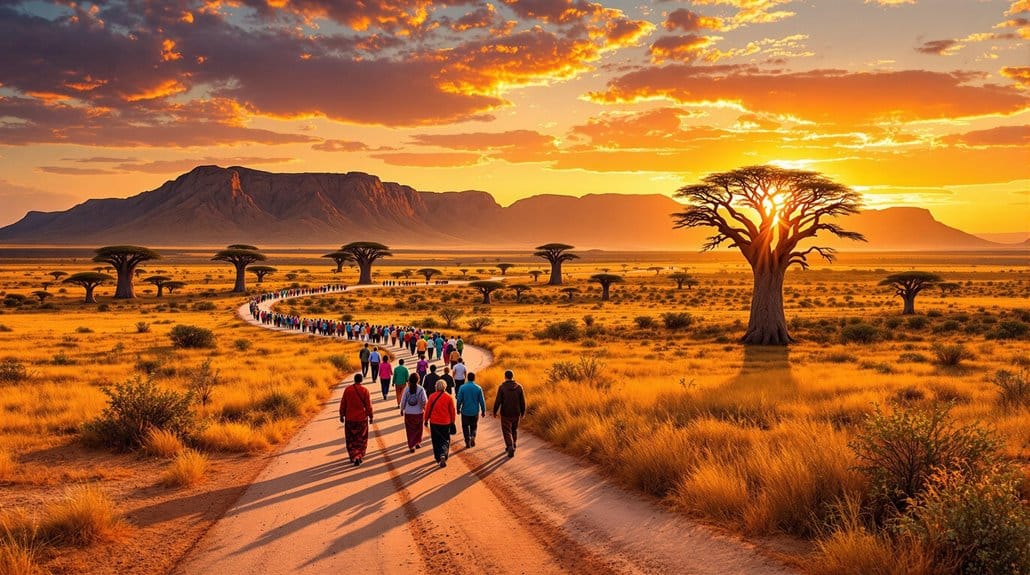Africa's historic pilgrimage routes offer you a chance to blend spirituality and cultural exploration. From the majestic Cape Camino to the revered paths leading to Lalibela, each journey invites personal reflection and growth. Along the way, you'll engage with vibrant local traditions, discover sacred sites, and experience the warmth of community support. While the routes may challenge you physically and mentally, the rewards include deep connections and transformative encounters. As you prepare for this enlightening adventure, you'll uncover invaluable insights that can enhance your experience—there's so much more to discover about these remarkable journeys.
Key Takeaways
- Africa's pilgrimage routes, like the Cape Camino and Hajj, offer spiritual journeys through diverse terrains and rich cultural heritage.
- Engaging with local communities enhances the pilgrimage experience through storytelling, traditional music, and culinary experiences.
- Pilgrimages challenge both physically and mentally, fostering personal growth and deepening spiritual connections along the journey.
- Adequate preparation, including appropriate gear and timing, is crucial for a rewarding pilgrimage experience.
- Educational initiatives, such as Tenda Primary School, benefit from tourism, promoting literacy and skills within local communities while fostering sustainable practices.
Overview of Pilgrimage Routes
When you explore Africa's historic pilgrimage routes, you'll discover a rich tapestry of spiritual journeys that interweave culture, history, and breathtaking landscapes. The Cape Camino in South Africa, stretching 550 kilometers, invites you to traverse its diverse terrain, connecting spiritual attractions like shrines and natural sacred spaces.
This route embodies the essence of pilgrimage, much like Japan's Kumano Kodo, which showcases the significance of trails linking important religious sites.
As you walk along these paths, you'll find opportunities for profound personal growth and spiritual reflection. Each step immerses you in the local culture, allowing you to experience the unique traditions and stories that define these sacred spaces.
In addition to the Cape Camino, Africa boasts other routes that highlight the deep connection between spirituality and environment, often offering thrilling wildlife experiences. Imagine walking with rhinos in Zimbabwe, Zambia, or Uganda, where nature becomes a part of your pilgrimage.
The evolution of these routes, enhanced by modern tourism practices, makes them more accessible. This blend of history, culture, and spirituality is what transforms your journey into a deeply enriching experience, fostering a sense of belonging in the heart of Africa.
Notable African Pilgrimage Sites
What makes Africa's pilgrimage sites so enchanting? They offer a rich tapestry of spirituality, history, and community, inviting you to connect with both the land and your African ancestors.
Whether you're seeking solace or adventure, these sites promise a transformative experience. Here are four notable pilgrimage destinations:
- The Hajj: This sacred journey to Mecca and Medina is required for Muslims, embodying a powerful spiritual commitment that millions undertake each year.
- Cape Camino: Stretching 550 kilometers in South Africa, this pilgrimage is inspired by the Camino de Santiago, showcasing shrines and stunning landscapes that foster deep introspection and connection.
- Lalibela: Famous for its monolithic churches, Lalibela in Ethiopia draws Orthodox Christians, especially during Christmas, highlighting the intersection of culture and faith.
- Mount Kilimanjaro: Known for its breathtaking beauty, this majestic mountain serves as a spiritual haven, much like sacred mountains across the globe.
These sites not only enrich your understanding of African spirituality but also weave together the stories of countless pilgrims who've walked these paths before you.
Spiritual Significance of Pilgrimages
Starting on a pilgrimage in Africa isn't just about the destination; it's a deeply transformative journey that resonates with the soul. As you walk these historic routes, you engage in spiritual renewal, deepening your faith while connecting with sacred traditions. The emotional and spiritual reflections you experience foster a greater understanding of ancestral legacies, enriching your sense of belonging.
| Spiritual Aspect | Personal Reflection | Ancestral Connection |
|---|---|---|
| Mindfulness | Self-discovery | Respect for histories |
| Community bonding | Emotional healing | Compassion for injustices |
| Sacred sites | Personal confrontation | Collective awareness |
| Deepened faith | Spiritual growth | Understanding legacies |
These sacred sites become sanctuaries for you, providing opportunities to confront both personal and collective histories. Walking in the footsteps of ancestors, you cultivate compassion and respect, allowing the past to guide your present. This journey isn't just about physical movement; it's about embracing your spiritual significance and recognizing the profound interconnectedness of your experiences with those who came before you.
Cultural Heritage and Traditions
Amidst the vast landscapes of Africa, cultural heritage and traditions flourish along the continent's pilgrimage routes.
These journeys, like the Cape Camino in South Africa, not only honor spirituality but also celebrate the rich tapestry of local customs and practices. As you begin on these paths, you'll encounter vibrant expressions of African culture that resonate deeply within the communities.
Here are some key elements that define the cultural landscape of these pilgrimage routes:
- Storytelling: Oral traditions are essential, preserving histories and passing down wisdom through generations.
- Traditional Music and Dance: Expect communal gatherings filled with rhythmic beats and enchanting dances that bring people together in celebration.
- Sacred Sites: Pilgrimage destinations, such as Lalibela in Ethiopia, aren't just spiritual havens; they embody unique architectural traditions and historical narratives.
- Ancestral Honors: Much like the Matsu Pilgrimage in Taiwan, African pilgrimages often honor ancestral spirits, deepening the connection to the past.
Through these rich traditions, you'll feel a sense of belonging, weaving your journey into the vibrant fabric of African heritage.
Challenges and Rewards of Pilgrimages
Setting out on a pilgrimage in Africa presents a journey filled with both challenges and rewards, inviting you to push your physical and mental limits while deepening your connection to the land and its people.
You'll face intimidating terrains, like the high-altitude trek to Hemkund Sahib, where acclimatization is essential at 15,000 feet. On the Cape Camino, be prepared for unpredictable weather as you walk 12-25 kilometers daily, testing your endurance over multiple days.
Yet, amid these challenges lies the profound emotional and spiritual rewards. Each step can lead to transformative experiences that foster personal growth and a deeper appreciation for the diverse cultures you encounter.
Heritage sites like Elmina Castle evoke powerful reflections, offering opportunities for communal healing despite logistical hurdles.
These pilgrimages aren't just about reaching a destination; they're about the journey itself, the friendships you form, and the stories you share.
Embrace the challenges as they shape your experience, and savor the rewards that come from immersing yourself in Africa's rich history and vibrant traditions.
You'll find that every hardship faced on the trail is a stepping stone to a deeper connection with yourself and the world around you.
Preparing for Your Journey
Before starting your pilgrimage, a bit of preparation can transform your journey from intimidating to enriching. By taking the time to plan and equip yourself properly, you'll deepen your experience and connection to the sacred path ahead.
Here are four key steps to reflect on while preparing for your journey:
- Research Your Route: Familiarize yourself with the cultural and spiritual significance of your chosen pilgrimage, like the Cape Camino in South Africa. Understanding the history will enhance your appreciation.
- Gather Appropriate Gear: Invest in comfortable walking shoes and weather-appropriate clothing. Pack personal items that will support you throughout your trek, ensuring you're well-prepared for whatever comes your way.
- Choose the Right Time: Look into the best season for your pilgrimage. For example, the pilgrimage season for Adams Peak in Sri Lanka runs from December to May, peaking in January and February.
- Engage Local Guides: Connect with local guides or organizations that specialize in pilgrimage experiences. They can provide invaluable insights and help enrich your understanding of the route's historical context.
With these tips in mind, you'll be well on your way to an unforgettable journey.
Connecting With Local Communities
As you commence your pilgrimage, connecting with local communities along the route can greatly enhance your experience. Engaging with these vibrant groups fosters mutual understanding and cultural exchange, making your spiritual journey even more meaningful.
Along routes like the Cape Camino or Kumano Kodo, local residents often offer support services, such as cozy accommodations and guided tours, ensuring you feel welcomed and supported.
Participating in cultural activities with local populations, like those along the Inca Trail, allows you to immerse yourself in indigenous traditions, creating lasting memories.
You'll find that community engagement not only enriches your journey but also strengthens ties with initiatives like the Tenda Primary School in Uganda, where education and pilgrimage intersect.
Frequently Asked Questions
What Is the Best Pilgrimage for Beginners?
If you're looking for the best pilgrimage for beginners, consider the Cape Camino in South Africa.
It offers manageable sections that let you ease into your journey. As you prepare spiritually, gather essential gear like sturdy shoes and a comfortable backpack.
You'll walk through beautiful landscapes, making it a perfect way to connect with nature and yourself.
Embrace the sense of belonging you'll find among fellow pilgrims as you commence this enriching adventure.
What Is the Oldest Pilgrimage Route in the World?
Imagine stepping onto ancient pathways, where each footstep echoes the whispers of countless souls before you.
The oldest pilgrimage route in the world is the Camino de Santiago, a sacred journey that's beckoned pilgrims for over a millennium.
As you traverse its scenic trails, you'll feel a deep connection to history and spirituality.
Each step brings you closer to the shrine of Saint James, inviting you to reflect and belong to something greater.
What Are the Three Great Pilgrimages?
When you think of the three great pilgrimages, you can't overlook their spiritual significance and rich cultural heritage.
First, there's the Hajj to Mecca, a profound journey for Muslims.
Next, the Camino de Santiago invites you to walk its historic trails in search of renewal.
Finally, the Kumbh Mela gathers millions of Hindus for sacred bathing.
Each pilgrimage creates a unique sense of belonging, connecting you to a larger community and shared traditions.
What Is the Most Famous Pilgrimage Walk?
When you commence on the renowned Camino de Santiago, you're not just walking; you're participating in a journey of profound spiritual significance and rich cultural heritage.
This celebrated pilgrimage, stretching across picturesque landscapes, invites you to reflect on life's deeper meanings.
As you tread along the ancient paths, you'll connect with fellow travelers, share stories, and embrace a sense of belonging that transcends borders, leaving you forever transformed by this sacred experience.
Conclusion
As you set off on your pilgrimage through Africa, remember that every step you take is a thread weaving you into a rich tapestry of culture, faith, and history. You'll not only discover breathtaking landscapes but also forge connections with local communities that can change your perspective. So, lace up your boots and embrace the journey—it's a chance to walk in the footsteps of those who came before you, creating memories that will last a lifetime.








